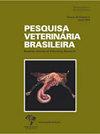Accidental monensin poisoning in buffaloes in Bahia, Brazil
IF 0.8
4区 农林科学
Q3 VETERINARY SCIENCES
引用次数: 1
Abstract
ABSTRACT: Monensin is an ionophore antibiotic (IA) widely used for growth promotion and weight gain in the production of ruminants. However, it has caused intoxication in several species, including buffaloes, mainly because of the ignorance or disrespect of the recommendations for use in each animal species. The objective of this study was to describe, for the first time, clinical-epidemiological and anatomopathological data of an outbreak of accidental poisoning by monensin in buffalos and rediscuss the recommendation of the use of IA in the production of this species. The outbreak affected 21 adult buffaloes after consumption of remains from a feed formulated on the farm and whose constituents were mixed by hand. Clinical and first death signs were observed 24 hours after ingestion of this food. In general, the clinical picture was characterized by muscle weakness, tremors, difficulty in locomotion, and decubitus. Fifteen buffaloes presented clinical signs of poisoning (71.5% morbidity), followed by death (100% lethality), after acute to subacute evolution (<24h to 96h). Laboratory tests indicated elevated serum activity of creatine phosphokinase and aspartate aminotransferase enzymes. Three buffaloes underwent necropsy, and samples from several organs were collected for histopathological examination. The main injuries found were hyaline degeneration and multifocal segmental necrosis in the skeletal and cardiac striated muscles (myopathy and degenerative-necrotic multifocal multifocal-necrotic cardiopathy). The diagnosis was confirmed by the toxicological evaluation of suspected ration remains, which detected 461.67mg/kg of monensin. The death of 71.5% buffaloes in this lot occurred due to a succession of errors, which included faults in the formulation of the ration and, above all, due to the use of monensin in a highly sensitive species. Despite the possible beneficial effects of IA use as a dietary supplement for buffaloes, we are of the opinion that IAs should never be used in bubalinoculture since any increment in production does not compensate for the imminent risk of death due to a small safety margin for this species and the absence of antidotes.巴西巴伊亚州水牛意外莫能菌素中毒
摘要:莫能菌素是一种离子载体抗生素,在反刍动物生产中广泛用于促进生长和增重。然而,它已经导致包括水牛在内的几个物种中毒,主要是因为对每种动物的使用建议的无知或不尊重。本研究的目的是首次描述莫能菌素在水牛中意外中毒暴发的临床流行病学和解剖病理学数据,并重新讨论在该物种生产中使用IA的建议。疫情影响了21头成年水牛,这些水牛食用了在农场配制的饲料残渣,其成分是手工混合的。在摄入该食物24小时后观察到临床和首次死亡迹象。一般来说,临床表现为肌肉无力、震颤、运动困难和卧位。15头水牛在急性到亚急性(<24h ~ 96h)进化后出现中毒临床症状(发病率71.5%),随后死亡(致死率100%)。实验室检查显示血清肌酸磷酸激酶和天冬氨酸转氨酶活性升高。对3头水牛进行尸检,并采集多个器官标本进行组织病理学检查。发现的主要损伤是骨骼和心脏横纹肌的透明变性和多灶节段性坏死(肌病和变性-坏死多灶性多灶性坏死心脏病)。对疑似口粮残余物进行毒理学评价,检出莫能菌素461.67mg/kg。这批水牛中71.5%的死亡是由于一系列错误造成的,其中包括口粮配方中的错误,最重要的是,由于在高度敏感的物种中使用莫能菌素。尽管将IA作为水牛的膳食补充剂可能会产生有益的影响,但我们认为,IAs不应用于水牛养殖,因为任何产量的增加都无法弥补由于该物种的安全边际较小以及缺乏解药而导致的即将发生的死亡风险。
本文章由计算机程序翻译,如有差异,请以英文原文为准。
求助全文
约1分钟内获得全文
求助全文
来源期刊

Pesquisa Veterinaria Brasileira
农林科学-兽医学
CiteScore
1.30
自引率
16.70%
发文量
41
审稿时长
9-18 weeks
期刊介绍:
Pesquisa Veterinária Brasileira - Brazilian Journal of Veterinary Research (http://www.pvb.com.br), edited by the Brazilian College of Animal Pathology in partnership with the Brazilian Agricultural Research Organization (Embrapa) and in collaboration with other veterinary scientific associations, publishes original papers on animal diseases and related subjects. Critical review articles should be written in support of original investigation. The editors assume that papers submitted are not being considered for publication in other journals and do not contain material which has already been published. Submitted papers are peer reviewed.
The abbreviated title of Pesquisa Veterinária Brasileira is Pesqui. Vet. Bras.
 求助内容:
求助内容: 应助结果提醒方式:
应助结果提醒方式:


